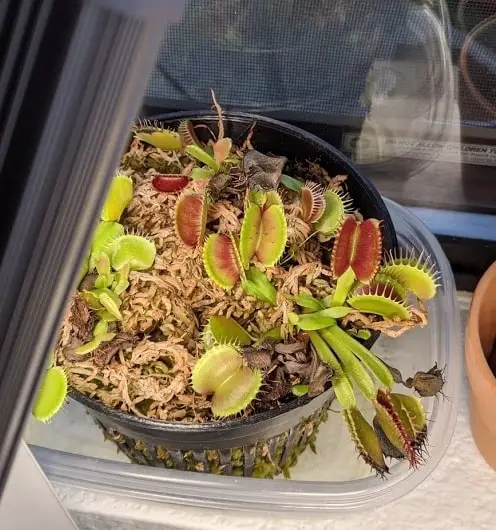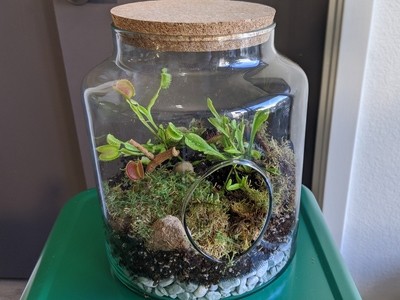Venus flytraps and succulents are both popular plants. In this article, we will explore the possibilities of growing Venus flytraps and succulents together.
Venus flytraps and succulents should not grow in the same pot, as their potting soil and watering requirements vary greatly. Still, succulents and Venus flytraps can be grown in the same environment if kept in separate pots.
Learn the best strategies to grow Venus flytraps and succulent in your home while keeping them both healthy.
Can Venus Flytraps Grow With Succulents in the Same Pot?
Venus flytraps and succulents have different growing requirements.
They both need lots of sunlight, but their humidity, watering, and potting media requirements vary greatly.
Venus flytraps and succulents should never be grown in the same pot. Each plant needs a different soil type. Also, Venus flytraps must remain in humid soil at all times. The high-humidity environment Venus flytraps prefer will rot and kill succulents
Venus flytraps can’t be potted in standard potting soil (here is a guide on how to pot your plants) (here is a guide on how to pot your plants). They need nutrient-free soil made up of moss with some drainage element, such as perlite or sand.
Succulents also need soil with good drainage. Also, succulent need soil with nutrients and fertilizers to thrive.
The nutrients in succulent soil can weaken and kill Venus flytraps. Also, the lack of nutrients in carnivorous plant soil is unsuitable for succulents.
Besides the soil requirement, Venus flytraps and succulent should be grown at very different humidity levels. Venus flytraps thrive in humid environments. Succulents prefer a dry environment.
You must water Venus flytraps very often to keep them healthy (here is a guide on watering that can help you use the optimal amount).. The soil should remain moist at all times. If you are unfamiliar with the watering process, you can learn all about it with this guide: Venus Flytrap Watering Instruction Guide.
Succulents need water every once in a while, but you must let the soil dry out quickly (hence the well-draining soil).
Even though Venus flytraps should not be grown in the same pot as succulents, they can be grown in the same setup.
What Plants Can Grow With Venus Flytraps in the Same Container
Many plants can be suitable companion plants for Venus flytraps. Here are a few options you can consider:
- Drosera / Sundew
- Sarracenia
- Live moss
- Other Venus flytrap cultivars
Drosera plants are also carnivorous plants. They thrive in carnivorous plant soil with high humidity levels. There are many different types of Sundew, so you have many options to choose from. I recommend selecting a Sundew that requires dormancy. Since Venus flytraps require dormancy, another plant that needs dormancy is optimal.
Sarracenia is also a carnivorous plant and it is a perfect companion plant for Venus flytraps.
Live moss thrives in high humidity environments. Also, it is a low-maintenance plant that will make any pot look beautiful.
You can choose to grow all of these plants in a single pot, maybe make a bog garden. I would not recommend growing them in a terrarium, as terrariums can be dangerous for Venus flytraps.
Growing Venus Flytraps and Succulents in the Same Setup
In this section, I will expand on how to grow succulents and Venus flytraps in the same location.
Growing Venus flytraps and succulent in the same setup is possible, as long as the plants grow in different containers.
Since, Venus flytraps and succulent have very diparate requirements, you must treat them very differently.
Lighting: Venus flytraps and succulents thrive in sunny locations. You can grow them outside to take advantage of bright sunlight or indoors with artificial lighting. Make sure both plants receive enough light exposure. Venus flytraps should optimally receive 12 hours of sunlight a day, but they can grow healthy with more than six.
Research about your succulents and their lighting requirements, and keep in mind most succulents need 12+ hours of sunlight.
Watering: Venus flytraps and succulents are very different in terms of water.
Venus flytraps thrive in very humid conditions. They must be watered often enough, so the soil never dries out completely. Also, Venus flytraps need pure water. They can’t be watered with standard tap water or bottled water. Instead, employ distilled water, reverse osmosis water, or rainwater.
You can also water succulents with pure water, but it is not a requirement. Contrary to Venus flytraps, succulent prefer dry media.
Soil: Use two different soils for your Venus flytrap and succulents. Venus flytraps need carnivorous plant soil.
Succulents are more flexible in potting media. And the recommended media might vary depending on the species.
Humidity: Venus flytraps thrive in high humidity environments. Still, Venus flytraps can live in arid environments.
I live in Arizona, and the climate is arid year-round. My Venus flytraps take a few weeks to adapt but eventually acclimate to the weather. I have never employed a humidifier, but it can be beneficial for Venus flytraps.
Succulents prefer dry climates. If you grow succulents and Venus flytraps together, avoid using a humidifier. Also, only mist your Venus flytraps. Succulents do not need misting.
Outdoor vs Indoor growing: Both Venus flytraps and succulents can be grown indoors or outdoors.
If you decide to grow your plants indoors, make sure they will have enough access to lighting. I grow many of my plants indoors.
I recommend using artificial lighting to ensure Venus flytraps remain healthy. You can use fluorescent or LED lights. Both types of grow lights are inexpensive and practical options. When choosing fluorescent bulbs, pick cool colors that promote growth. I have used this LED plant light (which costs less than $30) to grow some of my Venus flytraps, and they are healthy.

Potting containers: Succulents can grow in a wide array of potting containers from many different materials. I prefer using pots with drainage to prevent rotting.
Venus flytraps can be particular in terms of their potting container. First, it is greatly encouraged that you select a pot with drainage.
Also, pots made up us clay or terracotta can harm Venus fly traps. Those materials tend to leach minerals into the ground that are harmful to carnivorous plants. Opt for plastic, glass, or glazed ceramic containers for Venus flytraps.
Can Venus Flytraps and Succulents Use the Same Soil?
Succulent soil is not appropriate for Venus flytraps. Succulent soil varies in composition depending on the brand. But, all succulent soil contains some type of standard potting soil with tons of nutrients and fertilizers.
The nutrients in succulent soil are suitable for the vast majority of plants. However, carnivorous plants are susceptible to those components.
The nutrients and fertilizers present in succulent soil are harmful to Venus flytraps. Such nutrients cause mineral burns, weaken and eventually kill Venus flytraps. Never employ cactus or succulent soil for Venus flytraps. Instead, utilize carnivorous plant potting media.
Planting Venus flytraps in the wrong soil will kill the plant. Make sure you employ carnivorous plant soil. If you are unfamiliar with carnivorous plant soil, this article can teach you how to make it and where to buy it: The Best Soil Options for Venus Flytraps.
Venus flytraps need soil that lacks nutrients or fertilizers. Carnivorous plant soil is made up of pure moss and optionally an element for drainage, such as sand or perlite.
Thess are a few examples of carnivorous plant soil that are perfect for Venus flytraps:
- Pure peat moss
- Pure long-fibered sphagnum moss
- 4:1 or 2:1 ratio of peat moss and silica sand
- 4:1 or 2:1 ratio of peat moss and perlite
- 4:1 or 2:1 ratio of sphagnum moss and perlite
- 4:1 or 2:1 ratio of sphagnum moss and silica sand
Succulents won’t thrive in carnivorous plant soil. Most plants die when potted in carnivorous plant soil, as the dirt has no nutrients.
Avoid employing carnivorous plant soil for any other plant that is not carnivorous. Standard potting soil and succulent soil are available at most gardening stores.
Additional Care for Venus Flytrap
Venus flytraps have very particular growing requirements. For that reason, not many plants can act as companion plants in the same pot as Venus flytraps.
Before finding a companion plant for your Venus flytrap, you must make sure the growing environment is optimal for your plant.
Do not waste time searching the web to find Venus flytrap care information. This easy-to-follow guide contains all you need to know to grow healthy Venus flytraps: Ultimate Venus Flytrap Care Guide. Also, the guide includes a free care sheet you can download.


